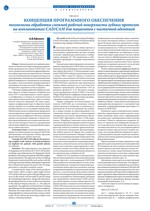Концепция программного обеспечения технологии обработки сложной рабочей поверхности зубных протезов на имплантатах cad/cam для пациентов с частичной адентией


Научно-практический журнал Институт Стоматологии №1 (102), апрель 2024
стр. 118-120
Аннотация
В рамках данного исследования предлагается новый способ проектирования управляющей программы для модели CAD/CAM, в том числе специальной кинематики формообразования зубных протезов для пациентов как с полной, так и частичной адентией, который заключается в моделировании геометрического взаимодействия рабочей поверхности с инструментом численными методами с использованием преобразованной в трехмерные числовые массивы 3D формы, обрабатываемой в заданной системе координат.
Учитывается форма рабочей поверхности зубного протеза, которая занимает полярный угол около 270° и многопроходность самого процесса шлифования, в котором по технологическим траекториям обязательно будут присутствовать участки холостого движения. По таким траекториям шлифовальный круг (в обратной схеме) должен перейти на соседнюю траекторию формообразования, то есть соседнюю эквидистанту. Обязательным является применение предельного закона управления скоростью срезания припуска для всего цикла шлифования. Поэтому в рамках данного исследования определен и введен алгоритм проектирования для создания автоматической системы контроля точности в программном обеспечении обработки сложной рабочей поверхности зубных протезов.
Учитывается форма рабочей поверхности зубного протеза, которая занимает полярный угол около 270° и многопроходность самого процесса шлифования, в котором по технологическим траекториям обязательно будут присутствовать участки холостого движения. По таким траекториям шлифовальный круг (в обратной схеме) должен перейти на соседнюю траекторию формообразования, то есть соседнюю эквидистанту. Обязательным является применение предельного закона управления скоростью срезания припуска для всего цикла шлифования. Поэтому в рамках данного исследования определен и введен алгоритм проектирования для создания автоматической системы контроля точности в программном обеспечении обработки сложной рабочей поверхности зубных протезов.
Аннотация (англ)
This study proposes a new approach to designing control software for CAD/CAM models, including a special kinematics for shaping the dental prostheses work surfaces for patients with both complete and partial adentia. The approach involves modeling the geometric interaction of the work surface with the tool using numerical methods, utilizing the transformed three-dimensional numerical arrays of the 3D shape processed in a specified coordinate system.
Considering the shape of the dental prosthesis work surface, which occupies a polar angle of about 270° and the multi-pass nature of the grinding process, areas of idle motion will inevitably be present along the technological trajectories. Along such trajectories, the grinding wheel (in reverse mode) must transition to the adjacent shaping trajectory, i.e., the adjacent equidistant. The application of the limit law of cutting speed allowance for the entire grinding cycle is mandatory. Therefore, this study defines and introduces into the design algorithm to create an automatic accuracy control system in the software for processing complex work surfaces of dental prostheses.
Considering the shape of the dental prosthesis work surface, which occupies a polar angle of about 270° and the multi-pass nature of the grinding process, areas of idle motion will inevitably be present along the technological trajectories. Along such trajectories, the grinding wheel (in reverse mode) must transition to the adjacent shaping trajectory, i.e., the adjacent equidistant. The application of the limit law of cutting speed allowance for the entire grinding cycle is mandatory. Therefore, this study defines and introduces into the design algorithm to create an automatic accuracy control system in the software for processing complex work surfaces of dental prostheses.
Ключевые Слова
технологии обработки поверхности зубных процессов, модели CAD/CAM, автоматизация изготовления зубных протезов, формообразование зубных протезов.
Ключевые Слова (англ)
dental surface processing technologies, CAD/CAM models, automation of dental prosthesis manufacturing, shaping of dental prostheses
Список литературы
/ REFERENCES:
1. Bi Y, Wu S, Zhao Y, etal. A newmethodforfabricatingorbitalprosthesiswith a CAD/CAM negativemold. J ProsthetDentistry 2013;110:424-8.
2. Bidra AS, Taylor TD, Agar JR. Computer-aidedtechnologyforfabricatingcompletedentures: systematicreviewofhistoricalbackground, currentstatus, andfutureperspectives. J ProsthetDentistry 2013;109:361-6.
3. Cantu AG, etal. Detectingcarieslesionsofdifferentradiographicextensiononbitewingsusingdeeplearning. J Dent. 2020;100:103425.
4. Grischke J, Johannsmeier L, Eich L, Griga L, Haddadin S. Dentronics: towardsroboticsandartificialintelligenceindentistry. DentMater. 2020;36:765-78.
5. Han, Weili MMetal. Design andfabricationofcompletedenturesusing CAD/CAM technology. Medicine 96(1):p e5435, January 2017.
6. Harb, Islametal. (2023). Applications andperformanceofartificialintelligencemodelsinremovableprosthodontics: Journal ofProsthodontic Research. 10.2186/jpr.JPR_D_23_00073.
7. Infante L, Yilmaz B, McGlumphy E, et al. Fabricatingcompletedentureswith CAD/CAM technology. J ProsthetDentistry 2014;111:351-5.
8. Kositbowornchai S, Plermkamon S, Tangkosol T. Performance ofanartificialneuralnetworkforverticalrootfracturedetection: anexvivostudy. DentTraumatol. 2013;29:151-5.
9. Krizhevsky A, Sutskever I, Hinton GE. ImageNetclassificationwithdeepconvolutionalneuralnetworks. Commun ACM. 2017;60:84-90.
10. Li S, Liu J, Zhou Z, Zhou Z, Wu X, Li Y, etal. Artificialintelligenceforcariesandperiapicalperiodontitisdetection. J Dent. 2022;122:104107.
11. Mertens S, Krois J, Cantu AG, Arsiwala LT, Schwendicke F. Artificialintelligenceforcariesdetection: randomizedtrial. J Dent. 2021;115:103849.
12. Tian S, Wang M, Dai N, Ma H, Li L, Fiorenza L, etal. DCPR-GAN: dentalcrownprosthesisrestorationusingtwo-stagegenerativeadversarialnetworks. IEEE J Biomed Health Inform. 2022;26:151-60.
1. Bi Y, Wu S, Zhao Y, etal. A newmethodforfabricatingorbitalprosthesiswith a CAD/CAM negativemold. J ProsthetDentistry 2013;110:424-8.
2. Bidra AS, Taylor TD, Agar JR. Computer-aidedtechnologyforfabricatingcompletedentures: systematicreviewofhistoricalbackground, currentstatus, andfutureperspectives. J ProsthetDentistry 2013;109:361-6.
3. Cantu AG, etal. Detectingcarieslesionsofdifferentradiographicextensiononbitewingsusingdeeplearning. J Dent. 2020;100:103425.
4. Grischke J, Johannsmeier L, Eich L, Griga L, Haddadin S. Dentronics: towardsroboticsandartificialintelligenceindentistry. DentMater. 2020;36:765-78.
5. Han, Weili MMetal. Design andfabricationofcompletedenturesusing CAD/CAM technology. Medicine 96(1):p e5435, January 2017.
6. Harb, Islametal. (2023). Applications andperformanceofartificialintelligencemodelsinremovableprosthodontics: Journal ofProsthodontic Research. 10.2186/jpr.JPR_D_23_00073.
7. Infante L, Yilmaz B, McGlumphy E, et al. Fabricatingcompletedentureswith CAD/CAM technology. J ProsthetDentistry 2014;111:351-5.
8. Kositbowornchai S, Plermkamon S, Tangkosol T. Performance ofanartificialneuralnetworkforverticalrootfracturedetection: anexvivostudy. DentTraumatol. 2013;29:151-5.
9. Krizhevsky A, Sutskever I, Hinton GE. ImageNetclassificationwithdeepconvolutionalneuralnetworks. Commun ACM. 2017;60:84-90.
10. Li S, Liu J, Zhou Z, Zhou Z, Wu X, Li Y, etal. Artificialintelligenceforcariesandperiapicalperiodontitisdetection. J Dent. 2022;122:104107.
11. Mertens S, Krois J, Cantu AG, Arsiwala LT, Schwendicke F. Artificialintelligenceforcariesdetection: randomizedtrial. J Dent. 2021;115:103849.
12. Tian S, Wang M, Dai N, Ma H, Li L, Fiorenza L, etal. DCPR-GAN: dentalcrownprosthesisrestorationusingtwo-stagegenerativeadversarialnetworks. IEEE J Biomed Health Inform. 2022;26:151-60.
Другие статьи из раздела «Научные исследования в стоматологии»
- Комментарии
Загрузка комментариев...
|
Поделиться:
|

 PDF)
PDF)


